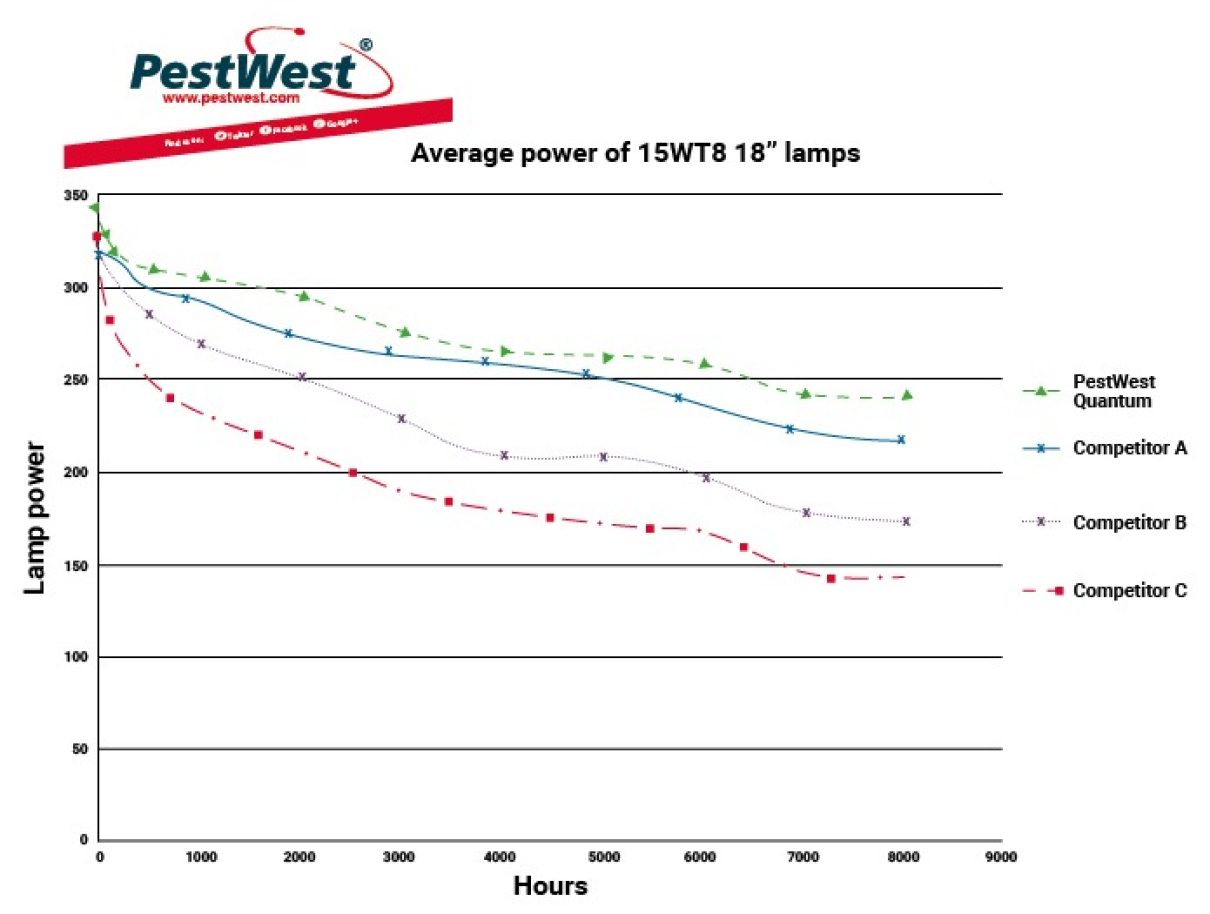You ask, we answer: Do all fly traps of identical lamp wattage (e.g., 30 watts) have the same fly control efficiency?
The simple answer is no.
There are now many choices out there in the marketplace and sometimes it can make choosing the right trap for a given situation more difficult. Sometimes pest controllers and users may think that they just need for example a 30 watt fly trap for a normal situation, such as in a kitchen or restaurant. There are however differences between brands and models, and the efficacy of a trap in terms of catching flying insects and the efficiency of the trap in terms of electrical consumption are often overlooked. When installing electronic fly traps in greater numbers, the electrical efficiency of the traps should not be ignored because the savings to the end user can be quite considerable. We only have to look at general lighting to see how LED’s (Light Emitting Diodes) have totally taken over the market in such a very short period of time, which is 100% driven by energy savings.
Differences between fluorescent lamps
First of all let’s look at the lamps used in electronic fly traps. There are now many insect attracting fluorescent lamps available on the market today, giving the pest controller and user many choices. The most important factors when considering the choice of fluorescent tube is not only how high the initial Ultraviolet (UV) light output is, but how well does the lamp maintain this output over a period of a year. The UV output of all insect attracting fluorescent lamps will reduce over time due to a slow degradation of the fluorescent powder coatings on the inside of the glass tube. The rate of this degradation varies between manufacturers, higher quality lamps have the slower degradation rates compared with cheaper brands, due to the design of the lamp and the quality of the materials used. Lower UV output levels in lamps used in electronic fly traps will reduce the attraction to flying insects.
A recent study comparing the UV output over time of various lamps on the market, revealed there were vast differences in both initial output and the degradation rate. See graph below.
Ballast and lamp system matching
It is also extremely important for the lamp and ballast employed in an electronic fly trap to be correctly matched. This ensures that the lamp starts and runs in the optimum rated electrical characteristics (Lamp Voltage, Lamp Current & Lamp Power), which in turn ensures that the lamp provides the optimum UV output and lamp life. The testing in the graph above was performed using magnetic ballasts which were matched to the lamps, and therefore operated them at their correct 15 watts operating lamp power.
We recently tested a 30W electronic fly trap which was made in China. The unit was a glue board type model with two 15W T8 18” tubes fitted. The lamps were powered by an electronic ballast which was not branded and was also made in China. When we accurately measured the lamp power using a power analyser we found the lamps to be running at 10.9Watts and 10.7Watts, respectively. This 30 Watt fly trap is in fact actually a 21.6 Watt fly trap. The ballast is clearly not matched to the lamps and is under driving them, the UV output from the lamps will be around 70% of that of a correctly matched lamp / ballast system. If you then couple that to inferior output tubes, such as competitor C lamps, you will find that the UV output could be as low as 54% of a suitably matched high quality lamp and ballast employed in a fly trap after 1000hrs operation (6 weeks).
Overall efficiency of the trap – electrical consumption
Unfortunately, fitting tubes of lower quality and UV output does not reduce the electrical consumption of the unit, as this is governed by the ballast employed as well as any other electrical components within the trap design. As a general rule, magnetic ballasts are typically 60-70% efficient and electronic ballasts are typically 80-90% efficient. What does this mean? Well it means that lamps/ballast convert most of the electricity into UV light and the rest is wasted as heat. So the most efficient fly traps will generally be the ones fitted with electronic ballast, from an electrical consumption point of view.
The cost benefits from using fly traps with electronic ballast are quite considerable when you are considering a reasonable number of fly traps per site. This in turn reduces the environmental impact and reduces electricity bills.
Table 1 – Energy Savings
| Electronic Fly Trap Type | Magnetic Ballast 2 x 15W | Electronic Ballast 2 x 15W | Savings |
|---|---|---|---|
| Electrical Power Consumption | 38 Watts | 32 Watts | |
| Cost per day | 14.5p | 12p | 2.5p |
| Cost per year | £52.93 | £43.20 | £9.73 |
| Cost to run 10 traps per year | £529 | £432 | £97 |
| Cost to run 20 traps per year | £1058 | £864 | £194 |
| Cost to run 50 traps per year | £2647 | £2160 | £487 |
*Calculated with an average cost of electricity of 16p per kilo Watt Hour (kWh).
As you can see from the above table, the savings when installing electronic fly traps fitted with electronic ballasts can be significant, especially when the number of traps increases. During the 10 year lifetime of these products a facility with 50 energy efficient fly traps could see savings of up to a whopping £4870.
Trap Design
One thing to remember when choosing the right trap is that ‘eye catching, does not always mean fly catching!’.
The more effective designs will have good openings to allow the UV light from the tubes to escape into the room and allow the flies to enter the trap and be caught on the adhesive board or high voltage grid etc. Some designs comprise this to suit certain situations which are more sensitive to the presence of a fly trap, such as front of house areas in restaurant, etc.
Conclusion
Choosing the right electronic fly trap for a given situation is important and careful consideration should be taken, to look at the quality of the product and components within. Choosing a product with an electronic ballast will reduce energy bills and have a better environmental impact. Choosing a trap from a reputable manufacturer will ensure that the unit is fitted with quality components which have been designed and tested to work at their optimum performance. The quality of the lamps employed in the traps also plays a major role in the performance of the trap and careful consideration should be taken when deciding which brand of lamps to service the trap with throughout its operating life.
Was this article helpful? We will be happy to receive your feedback,
questions and experience via Email or Facebook.













